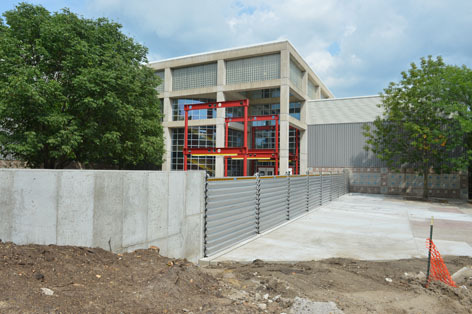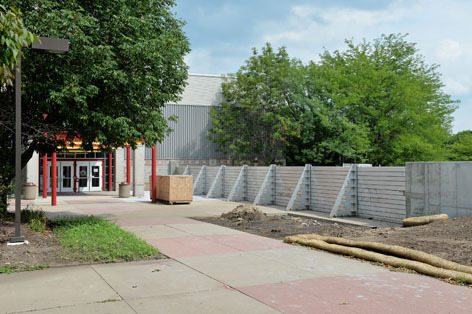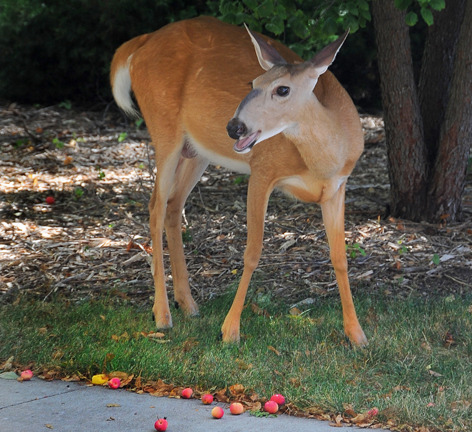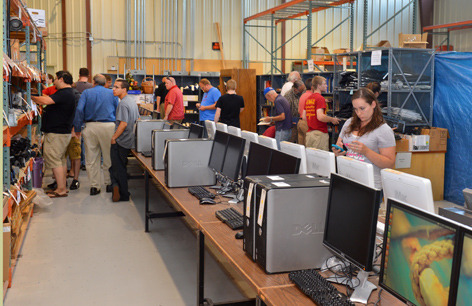Water tight


Flood mitigation work outside the Lied Center will wrap up soon. A system of earthen berms and concrete fortified gateways were installed to protect the building from flood water. Similar to the mitigation measures at the Iowa State Center, interlocking aluminum logs will be inserted at two gateways near the west building entrance (both sides of one gateway are pictured above) and a gateway near the southeast entrance when needed. Campus crews will finish site preparations in the coming days, including hydroseed application to the berms. Photos by Bob Elbert.
Growing the faculty
Iowa State is making progress on President Steven Leath's pledge last fall to build both the number and the excellence of the university's faculty. Since then, 60 tenured or tenure-track faculty members accepted positions on campus for the 2013-14 academic year.
During his installation address last September, Leath shared his intent to bolster faculty recruitment, particularly in areas "critical to Iowa's economic future" -- the biological sciences, agriculture, physical sciences and engineering. He announced a first target of 200 additional tenured or tenure-track faculty. More than half of this year's hires are in these targeted fields.
In the last decade, the annual number of new tenure-track faculty has ranged from 45 to 100 new hires.
"Hiring faculty is a priority of our departments and colleges. I can't think of a situation here in which a college or department doesn't have that at the top of its 'to-do' list," said associate provost Dawn Bratsch-Prince. "I think we're all on the same page that we want to grow the faculty -- and in the right way. It's possibly a lifetime commitment we're making to a faculty member."
The office of the senior vice president and provost has the authority to hire tenured and tenure-track faculty members; hiring responsibility for non-tenure eligible faculty rests with college deans.
Bratsch-Prince offered some insight into the recruiting process and the variables in play:
Strong job market. Higher education has eased past the economic downturn of a few years ago and good jobs are more plentiful, she said. Strong universities are vying for the same pool of applicants, so there's more competition for the top candidates. During the lean years, there were more candidates than there were positions to fill.
Hiring to retain. "We want to hire the best-qualified people, those we believe will be successful and will stay at Iowa State," Bratsch-Prince said. She noted that several departments this year closed a search when they weren't able to hire their top candidates. "Their applicant pool wasn't as deep as they'd hoped for. They'll regroup and reopen the search when perhaps they can attract a more robust pool of candidates," she said.
It's cyclical. Iowa State always is in search mode, Bratsch-Prince said, and each discipline has its own hiring cycle. That cycle may be tied to specific conferences, at which interviews typically occur. The cycle might begin in September or January or April, depending on the discipline. Some departments succeed quickly with their searches; for others, it's a longer process.
Focus on humanities salaries. One of the university's initiatives this spring was to raise faculty salaries in the humanities to be more competitive with Iowa State's peer universities. Leath, senior vice president and provost Jonathan Wickert and Liberal Arts and Sciences dean Beate Schmittmann collectively put $450,000 into salaries and benefits for faculty in six departments: English, Greenlee School of Journalism and Communication, history, music and theatre, philosophy and religious studies, and world languages and cultures.
"Salary is a concern at any university. The humanities faculty do teach a lot of our students and we want to keep the good faculty that we have," Bratsch-Prince said.
Beyond 200. Leath set a first target of 200 new faculty in his speech last fall. He also set a goal of increasing Iowa State's graduate student body by 2,000. "We're looking to increase our faculty numbers in those areas where we have strong or up-and-coming graduate programs," Bratsch-Prince said.
Investment in retention. "We can hire all the faculty in the world, but if we don't have an environment in which they can be successful, we'll lose them," Bratsch-Prince said. The provost office is investing money and time particularly in targeted professional development for early-career and mid-career faculty and for department chairs.
"That investment helps us keep the people we hire and create a community that's attractive to new hires, too," she said.
August 2012-August 2013: New tenure-track faculty by college
Departments with 2 or more hires
|
Business |
4 |
|
Design |
4 |
|
Veterinary Medicine |
5 |
|
Human Sciences |
8 |
|
Agriculture and Life Sciences |
10 |
|
Engineering |
10.5* |
|
Liberal Arts and Sciences |
18.5* |
|
TOTAL |
60 |
* Reflects split appointment
Regents approve final budget, transparency recommendations
The state Board of Regents gave the FY14 university budget the final OK, endorsed recommendations of a transparency task force and heard a report on ISU's strategic plan during its Aug. 8 meeting in the Memorial Union. The board also approved the creation of one center and the closing of two other centers and the Harkin Institute.
FY14 budget
Iowa State's FY14 total budget is just shy of $1.29 billion, an increase of approximately $76 million (6 percent) over the FY13 budget. It includes a general fund operating budget of $614.2 million and restricted funds budget of $675.6 million.
In budget remarks to the regents, President Steven Leath said the university would allocate $35 million in new revenues to four overarching priorities -- "maintaining academic excellence, enhancing our basic and applied research efforts, promoting economic development and improving our campus environment, which has become especially critical with our enrollment growth."
Among allocations highlighted by Leath were:
- $4 million for additional student advising, supplemental instruction, internship support, enhanced writing programs, media help centers, classroom and technology improvements and learning community enhancements
- $5.5 million to recruit and retain faculty in disciplines in which the university is excelling or has particular demands in teaching
- $450,000 to retain humanities faculty
- $1.5 million ($4.5 million over three years) to expand collaboration with external partners on applied research. The funds will go to "large multidisciplinary research projects that will enable us to secure large federal grants," Leath said. "One is in vaccine development, one is in crop bioengineering and another is in global food security, which are all strengths of Iowa State."
- $400,000 to expand doctoral and post-doctoral scholarships
- $350,000 for high-performance computing necessary for "big-data" initiatives
- $514,000 to extend hours and increase security at the library, add public safety and facilities staff and enhance the university's emergency management and preparedness system
Leath also described how two special purpose state appropriations -- $7.5 million to the Bioeconomy Initiative and $12 million to the ISU Research Park -- will be allocated.
Bioeconomy Initiative funds will be used to improve the research infrastructure, invest in research projects with strong entrepreneurial potential and attract more high-performing graduate students. Research park funds will finance construction of a new facility to house services and agencies that assist businesses.
Transparency Task Force recommendations
The regents reviewed and approved recommendations (PDF) of its nine-member Transparency Task Force, a group charged with recommending best practices for responding to public information requests and giving Iowans access to information. Among other things, the task force recommended that:
- Each public university appoint a transparency officer to log and track public records requests
- All public records requests be listed on university websites
- Each university and the board office hold a public comment hearing prior to every board meeting
Strategic plan progress report
Senior vice president and provost Jonathan Wickert presented a strategic plan progress report to the regents. He noted that in this fifth consecutive year of rising enrollment, "faculty and staff on campus have been working very hard to be able to meet student demand and to make sure that students are able to get the classes they need on time and to keep them on track for their graduation."
He highlighted efforts to increase the availability of student housing, provide new and upgraded classroom and study space, keep labs open for longer periods of time, retain top faculty and strengthen academic assistance to students.
Wickert also noted successes in research and technology and in serving Iowans through extension and outreach. "We see Iowa State as a 99-county campus," he said.
ISU centers
Iowa State received permission to close two centers or institutes and open one. Those closing are:
- Harkin Institute of Public Policy, College of Liberal Arts and Sciences. The institute was created in 2011 to facilitate research and public access to Sen. Tom Harkin's papers upon his retirement. In May, Harkin announced he would donate his papers to Drake University.
- Iowa Center for Research on Botanical Dietary Supplements, College of Human Sciences, created in 2003. The center received $17 million from federal sources through 2010. Federal funding was not renewed in 2011 and the center is no longer financially sustainable.
The new center is the Iowa Nutrient Research Center in the College of Agriculture and Life Sciences. Created by state legislation during the 2013 session, the center will coordinate research and innovation that focuses on water quality and reducing farm field nutrients that make it to waterways. A $1.5 million state appropriation in FY14 and FY15 will support the center.
New programs
The regents approved two new academic programs at Iowa State:
- The new master of finance is a full-time residential program in the College of Business.
- The new bachelor of science program in public relations makes a stand-alone program out of the popular public relations emphasis that has been available to journalism students for about a decade. The program is in the Greenlee School of Journalism and Communication, College of Liberal Arts and Sciences.
Name changes
The regents approved name changes for several programs. They're now called:
- Master of science and Ph.D. in agricultural and biosystems engineering (from M.S. and Ph.D. in agricultural engineering), College of Engineering
- Bachelor of science in financial counseling and planning (from B.S. in family finance, housing and policy), College of Human Sciences
Other action
In other action, the board:
- Approved a 4 percent pay increase for President Leath. His base salary for FY14 is $466,752.
- Heard a presentation about a landscape architecture class' role in developing a multipurpose outdoor classroom on the new campus of the Iowa Correctional Institution for Women, Mitchellville
- Changed its own policy manual (chapter 8) to prohibit resident undergraduate tuition from being used for student financial aid. The 2013 Legislature approved a bill that likewise prohibits this use. However, tuition collected from nonresident students still may be "set aside" for financial aid.
- Approved a revised budget of $7.742 million for the Jeff and Deb Hansen Agriculture Student Learning Center (up from $7.3 million). The additional funds include private gifts ($300,000) and university funds ($142,000). All nine bids received for the project exceeded the estimate, so revisions were made to the building plans.
Oh, deer

This deer stopped to dine on a few crabapples outside the west entrance of the Communications Building. Deer sightings are not uncommon on campus, especially near Pammel Woods, according to facilities planning and management.
If you see deer on campus, don't spook them because they tend to run wildly, often into the path of a car. FPM staff say deer cause relatively little damage to the landscape. Sometimes staff must discourage bucks from scratching their antlers on trees.
Rabbits? Now that's a different story. Photo by Bob Elbert.
For your calendar: Opening events
Here's a compilation of college and university events scheduled to officially launch the 2013-14 academic year:
College events
- Agriculture and Life Sciences: Convocation, Sept. 10 (4:10 p.m., Harl Commons, Curtiss Hall)
- Business: Faculty and staff family picnic, Aug. 23 (6-8 p.m., Maple Shelter, Brookside Park)
- Design: Welcome reception, Aug. 26 (6-8 p.m., King Pavilion, College of Design, program at 6:45 p.m.)
- Engineering: Convocation, Sept. 3 (3:10-4 p.m., auditorium, Howe Hall, reception follows in the atrium)
- Human Sciences: Faculty and staff convocation, Aug. 22 (7:45-11 a.m., Reiman Ballroom, ISU Alumni Center)
- Liberal Arts and Sciences: Convocation and reception, Sept. 11 (4-6 p.m., Memorial Union Sun Room)
- Veterinary Medicine: Convocation, Oct. 2 (8-9 a.m., 1226 Vet Med)
University events
- Academic year opening address, President Steven Leath, Sept. 13 (8 a.m., MU Great Hall)
- University faculty and staff awards ceremony, Oct. 2 (3:30-4:30 p.m., MU Sun Room, reception follows)
It's all there

Desks, laptop computers, Elmo projectors, photography equipment, insulated coffee carafes, centrifuges. It was another afternoon of hunting for treasures Wednesday at the weekly ISU Surplus sale.
Used furniture and equipment (scientific, classroom and office) that's been removed from the university's inventory is sold at discounted prices on Tuesdays and Wednesdays at Iowa State's surplus and storage facility off of Airport Road in south Ames. The Tuesday sale (10 a.m.-noon) is reserved for ISU departments and state-funded offices. The Wednesday sale (noon-3 p.m.) is open to the public.
Items at the surplus sale have a split ticket. If you decide to purchase an item, remove the bottom portion of the ticket and bring it to the checkout cashier. You must pay for your purchases with cash or a check.
ISU Surplus, a unit within Central Stores, sells large items – for example, vehicles or large quantities of an item – on a government surplus auction website, GovDeals. Check ISU Surplus' Facebook page for frequent updates on warehouse sale items and newly posted auction items.
The university surplus and storage facility is located east of the research park at 1102 Southern Hills Dr.
Photos by Bob Elbert.

